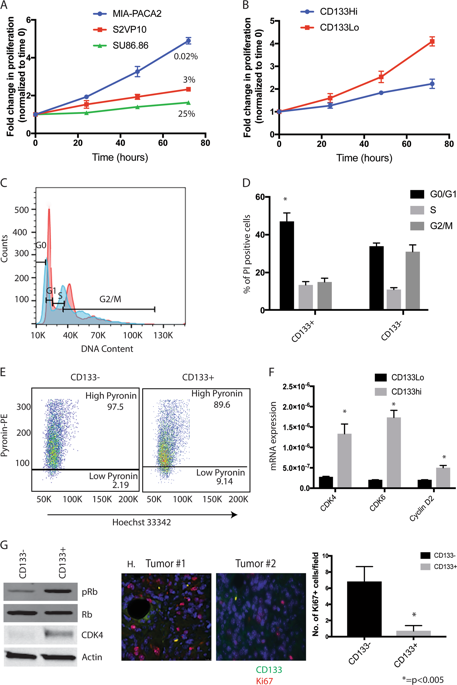当前位置:
X-MOL 学术
›
Oncogenesis
›
论文详情
Our official English website, www.x-mol.net, welcomes your feedback! (Note: you will need to create a separate account there.)
Long non-coding RNA GAS5 acts as proliferation "brakes" in CD133+ cells responsible for tumor recurrence.
Oncogenesis ( IF 6.2 ) Pub Date : 2019-11-18 , DOI: 10.1038/s41389-019-0177-4 Nikita S Sharma 1 , Prisca Gnamlin 1 , Brittany Durden 1 , Vineet K Gupta 1 , Kousik Kesh 1 , Vanessa T Garrido 1 , Vikas Dudeja 1, 2 , Ashok Saluja 1, 2 , Sulagna Banerjee 1, 2
Oncogenesis ( IF 6.2 ) Pub Date : 2019-11-18 , DOI: 10.1038/s41389-019-0177-4 Nikita S Sharma 1 , Prisca Gnamlin 1 , Brittany Durden 1 , Vineet K Gupta 1 , Kousik Kesh 1 , Vanessa T Garrido 1 , Vikas Dudeja 1, 2 , Ashok Saluja 1, 2 , Sulagna Banerjee 1, 2
Affiliation

|
Presence of quiescent, therapy evasive population often described as cancer stem cells (CSC) or tumor initiating cells (TIC) is often attributed to extreme metastasis and tumor recurrence. This population is typically enriched in a tumor as a result of microenvironment or chemotherapy induced stress. The TIC population adapts to this stress by turning on cell cycle arrest programs that is a "fail-safe" mechanism to prevent expansion of malignant cells to prevent further injury. Upon removal of the "stress" conditions, these cells restart their cell cycle and regain their proliferative nature thereby resulting in tumor relapse. Growth Arrest Specific 5 (GAS5) is a long-non-coding RNA that plays a vital role in this process. In pancreatic cancer, CD133+ population is a typical representation of the TIC population that is responsible for tumor relapse. In this study, we show for the first time that emergence of CD133+ population coincides with upregulation of GAS5, that reprograms the cell cycle to slow proliferation by inhibiting GR mediated cell cycle control. The CD133+ population further routed metabolites like glucose to shunt pathways like pentose phosphate pathway, that were predominantly biosynthetic in spite of being quiescent in nature but did not use it immediately for nucleic acid synthesis. Upon inhibiting GAS5, these cells were released from their growth arrest and restarted the nucleic acid synthesis and proliferation. Our study thus showed that GAS5 acts as a molecular switch for regulating quiescence and growth arrest in CD133+ population, that is responsible for aggressive biology of pancreatic tumors.
中文翻译:

长的非编码RNA GAS5在负责肿瘤复发的CD133 +细胞中充当增殖“刹车”。
通常被称为癌症干细胞(CSC)或肿瘤起始细胞(TIC)的静态,治疗性逃避人群的存在通常归因于极端转移和肿瘤复发。由于微环境或化学疗法诱发的压力,该人群通常在肿瘤中富集。TIC人群通过启动细胞周期停滞程序来适应这种压力,这是一种“防故障”机制,可防止恶性细胞扩增,从而防止进一步的伤害。消除“应激”条件后,这些细胞重新开始其细胞周期并恢复其增殖性质,从而导致肿瘤复发。生长停滞特异性5(GAS5)是一种长期的非编码RNA,在此过程中起着至关重要的作用。在胰腺癌中 CD133 +群体是TIC群体的典型代表,可导致肿瘤复发。在这项研究中,我们首次显示CD133 +群体的出现与GAS5的上调相吻合,GAS5通过抑制GR介导的细胞周期控制来重编程细胞周期以减缓增殖。CD133 +种群进一步将代谢产物(如葡萄糖)引导至分流途径(如戊糖磷酸途径),尽管其本质上是静止的,但主要是生物合成的,但并未立即用于核酸合成。抑制GAS5后,这些细胞便从其生长停滞中释放出来,并重新开始核酸合成和增殖。因此,我们的研究表明,GAS5充当调节CD133 +群体的静止和生长停滞的分子开关,
更新日期:2019-11-18
中文翻译:

长的非编码RNA GAS5在负责肿瘤复发的CD133 +细胞中充当增殖“刹车”。
通常被称为癌症干细胞(CSC)或肿瘤起始细胞(TIC)的静态,治疗性逃避人群的存在通常归因于极端转移和肿瘤复发。由于微环境或化学疗法诱发的压力,该人群通常在肿瘤中富集。TIC人群通过启动细胞周期停滞程序来适应这种压力,这是一种“防故障”机制,可防止恶性细胞扩增,从而防止进一步的伤害。消除“应激”条件后,这些细胞重新开始其细胞周期并恢复其增殖性质,从而导致肿瘤复发。生长停滞特异性5(GAS5)是一种长期的非编码RNA,在此过程中起着至关重要的作用。在胰腺癌中 CD133 +群体是TIC群体的典型代表,可导致肿瘤复发。在这项研究中,我们首次显示CD133 +群体的出现与GAS5的上调相吻合,GAS5通过抑制GR介导的细胞周期控制来重编程细胞周期以减缓增殖。CD133 +种群进一步将代谢产物(如葡萄糖)引导至分流途径(如戊糖磷酸途径),尽管其本质上是静止的,但主要是生物合成的,但并未立即用于核酸合成。抑制GAS5后,这些细胞便从其生长停滞中释放出来,并重新开始核酸合成和增殖。因此,我们的研究表明,GAS5充当调节CD133 +群体的静止和生长停滞的分子开关,


























 京公网安备 11010802027423号
京公网安备 11010802027423号